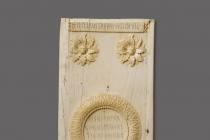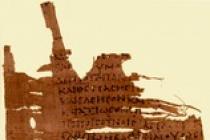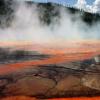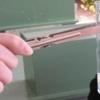By creating new capital spreading a new religion, Emperor Constantine the Great first of all begins the construction of the main temple of the Christian empire. For this, he was in 325 - 328 years. rebuilds an old pagan temple into a five-nave basilica. Great Basilica dedicated to Hagia Sophia- The wisdom of God.
But the pagan gods strongly opposed the new religion.
The Temple of Constantine the Great burned down during a popular uprising in 404. The newly built church on this site was destroyed by a fire in 415.
In the same year 415, Emperor Theodosius II ordered to build on this site a new large five-nave basilica, richly decorated with marble, with two-tiered galleries. But this temple was still very far from the greatness of today's Hagia Sophia.
The Theodosius Basilica burned down in 532 during the Nika uprising.
A month after the destruction of the basilica, Emperor Justinian begins construction of a new church of Hagia Sophia. According to his plan, this temple was to become the greatest Christian temple Byzantium.
This temple has survived destruction, earthquakes and wars.
Hagia Sophia stood for almost 1,500 years, remaining the largest church in the Christian world for over a thousand years.

Remains of a 415 basilica in the courtyard of Hagia Sophia

The Emperor Justinian invites two progressive mechanics of that time to build the temple - Isidore of Miletus and Anthimius of Trallsky (they had previously built). On the construction of the temple, 10,000 workers worked daily under the guidance of 100 craftsmen.
To build such a tall building of unprecedented size at that time and to cover it with a huge dome in a seismically dangerous area is not an easy task.
The sad experience of previous buildings made Isidore and Amfimius look for new ways to solve problems.
It was decided to install the main dome on 4 arches, each 31 m wide. But wide and high arches can collapse under their own weight even before the heavy dome is installed on them. It was necessary to find light and durable material for construction.
In earlier Roman buildings, volcanic ash and pumice - pozzolana - were added to the solution for this. But there were no such materials near Constantinople, and the construction time did not allow them to be transported from afar.
The most suitable and affordable building material was clay from the island of Rhodes, which has some special properties. Plinth bricks made of this clay were fired at low temperatures... With such firing, many pores were formed in the bricks, the plinth was so light that it did not sink in water.

Byzantine masonry.
The lime mortar between the bricks of Hagia Sophia is much thicker than in modern masonry, it contains a lot of broken bricks. The dome and its arches are more made of reinforced mortar than plinth.
In the manufacture of the mortar, not sea sand, but river sand with lime was mixed. And, according to legend, a secret ingredient - an extract of ash leaves - gave the mortar special strength.
The mortar and the brick are made of the same material and after hardening, the brick firmly adheres to the mortar, and if small cracks form in the building, over time they heal on their own.
Touching the main arches only at 4 points, the huge dome could split under its own weight. To prevent this from happening, the architects placed triangular concave sails between the arches to distribute the weight of the dome evenly. It was a progressive solution for the time.

Six-winged seraphim in sails.

To strengthen the main arches, semicircular arches of the side aisles around the main nave are used:

However, the weight of this structure was such that all the arches lost their semicircular shape even before the dome was installed, the giant columns bent, their tops cracked, and the square base of the dome was no longer square. It was no longer possible to install a round dome on it, which would evenly distribute the weight over all the supports.
The emperor urges the builders and the architects decide to build a less durable elliptical, flattened dome on a cylindrical base with 40 windows.
The temple is a basilica 77 m long and 72 m wide. To cover such a space with a dome, the architects resorted to optical illusion. They added structures on each side and covered them with semi-domes protruding from the main arches. These semi-domes support the main arches, and thus the main dome. And these semi-domes also have their own additional semi-domes of a smaller diameter.

This intricate system of domes made it possible to cover the huge nave without increasing the diameter of the main dome.
Numerous windows at the base of the domes illuminate the temple, creating intricate intersections of streams of light. The main dome seems to float in the air.
After the dome was installed, the interior decoration of the cathedral began. The walls and floors were covered with marble, the capitals of the columns were finely carved.

Amphilion - the place where the emperors of Byzantium were crowned on the throne.

Column capitals.

To decorate the temple during the construction process, marble columns were widely used - both new and brought from various old temples. From Rome, 8 porphyry columns were brought from the Temple of the Sun, and 8 columns of green marble from Ephesus.
The columns were installed on lead plates, which played the role of shock absorbers in case of an earthquake. The same plates were on the top of the columns.
Almost 1,500 years have passed, and the columns are still standing.




427 statues were installed in the temple, the doors of the main entrance were made of petrified wood of noah's ark.
All the emperors of Byzantium considered it their duty to search all over the world for Christian and biblical relics and shrines and deliver them to Constantinople by hook or by crook. Well, if it was not possible to find the relic, then ... all the same it had to be delivered to Constantinople. The legends had to have material confirmation.
Gold, silver and ivory were used to decorate the temple. Mosaic panels were laid out.
The mosaics at the beginning were not as colorful as they are today - they simply depicted a cross on a gold background, or an ornament. Panels with family portraits of emperors were created centuries later.


The construction of the temple consumed three annual income Byzantine Empire.
On December 27, 537, Justinian entered his new temple at the head of a large procession. "Solomon, I have surpassed you!" - the emperor boastfully exclaimed, referring to the legendary Jerusalem temple.

The Temple of Justinian stood for 20 years.
In 557-558 strong earthquakes occurred and the cylindrical base of the dome collapsed, causing the dome to collapse.
The temple was restored by Isidor's nephew, Isidor the Younger. He decides to get rid of the cylindrical base and slightly changes the shape of the dome, making it more round, less flat, and therefore more durable. And most importantly, he is in no hurry. It took him 4 years to repair the dome. The formwork supporting the center of the dome stood for a year until the mortar was completely set.
The dome of Isidore the Younger has stood for more than four centuries.
But the huge dome of Hagia Sophia has always been the weakest link in the structure.
In 989, a powerful earthquake again destroyed the main dome of the cathedral. The building was supported by buttresses, the collapsed dome was restored by the Armenian architect Trdat. Its dome turned out to be even more convex and has stood for more than 1000 years - to this day.
The beautiful mosaics of Hagia Sophia were created from the middle of the lX century to the end of the Xlll century, after the victory of the icon-worshipers over the iconoclasts. Along with the faces of the Savior, the Mother of God and the saints, the emperors did not forget to leave their portraits as a keepsake for their descendants.

Throne image of the Virgin in the apse.
From the mosaics of the Vl century, only a golden background remained in this picture, the image of the Virgin and the Child were destroyed during the iconoclastic period and restored in the second half of the lX century.
(And I distort pictures from Wikipedia, due to the poor quality of my photos)


Archangel Gabriel on the side of the Virgin Emperor Alexander

Emperor Leo Vl kneels downbefore the Savior(X - Xl centuries)

Emperors Constantine and Justinian before the Mother of God(mid-10th century)
On the mosaic panel, Emperor Constantine the Great presents as a gift to the Mother of God Constantinople, and Justinian is the temple of Hagia Sophia.
Constantinople has always been considered the city of the Mother of God and was under Her protection, and the expression "Your City, the Mother of God" served as a synonym for the word Constantinople.

Konstantin Monomakh and Empress Zoe before the Savior.
Empress Zoe (and it was she who ruled the empire) had three husbands. On the mosaic panel, when changing her husband, she ordered him to change his portrait every time. For this, the image of the emperor's head was knocked down twice.

Emperor John Comnenus and Empress Irina before the Mother of God


Deesis. The Theotokos and John the Baptist on the Day of Judgment ask Jesus Christ to have mercy on humanity (second half of the Xlll century) (Deesis is translated from Greek as petition, prayer).
Despite the fact that only one third of this mosaic has survived, there are always the most visitors in front of it.



Throughout its long life, Hagia Sophia has witnessed many events. Emperors were crowned here Byzantium... Here the Kiev prince Askold and princess Olga were baptized. The Byzantine princess Anna became the wife of the Kiev prince Vladimir and the condition for this marriage was the baptism of Vladimir and all of Russia.
On July 16, 1054, in the Cathedral of Hagia Sophia, the Patriarch of Constantinople was awarded a letter of excommunication from the Pope. So Catholicism separated from Orthodoxy.
In 1204 Constantinople was captured by the crusaders and plundered by brothers in the faith. The Hagia Sophia Cathedral was also plundered. Among the many treasures taken from the cathedral was the Shroud of Turin, which was kept here.
In 1453, after the fall Constantinople, Hagia Sophia was converted into the Hagia Sophia mosque. 4 minarets were added to the building and the interior was slightly changed. All the mosaics were covered with plaster, huge round shields of donkey skin were hung, on which the names of Allah and his prophets were written.


Mihrab built in the apse, indicating the direction to Mecca.

A canopy for the muezzin has been built.

Minbar was built - the place where the imam reads sermons and...

...luxurious Sultan's box.

Hellenic jugs brought from Pergamum.
Over the centuries, the best architects of the Ottoman sultans have struggled to surpass the Christian temple in grand size, dome height and diameter, beauty and significance. But - in vain.
All mosques Of Istanbul copy appearance Hagia Sophia, but remain just copies.
In 1935, according to the decree of Ataturk, Hagia Sophia became a museum, layers of plaster were removed from the mosaics, round shields with Islamic inscriptions were removed (however, after the death of the Father of the Turks, the shields were hung again).
Thousands of tourists from all over the world stand in huge queues to touch the former greatness of the ancient Empire.

Super construction of antiquity - Hagia Sophia in Istanbul.

To be continued...
Constantinople, Byzantium, Istanbul, Turkey.
The cathedral is located in the historical center of Istanbul in the Sultanahmet area. Today it is one of the symbols of the city and a museum.
Hagia Sophia is recognized as one of the greatest examples of Byzantine architecture that has survived to this day, which even sometimes called "the eighth wonder of the world."
 According to the Russian scientist N.P. Kondakov, this temple "did more for the empire than many of its wars." The Temple of Hagia Sophia in Constantinople became the pinnacle of Byzantine architecture and for many centuries determined the development of architecture in the countries of Western and Eastern Europe, the Middle East and the Caucasus.
According to the Russian scientist N.P. Kondakov, this temple "did more for the empire than many of its wars." The Temple of Hagia Sophia in Constantinople became the pinnacle of Byzantine architecture and for many centuries determined the development of architecture in the countries of Western and Eastern Europe, the Middle East and the Caucasus.

The temple is one of the most ancient and majestic structures related to the Christian religion. Hagia Sophia is considered the 4th museum in the world, equal in scale to such masterpieces as the Church of St. Paul in London, San Pietro in Rome and the House in Milan.

The name Sophia is usually interpreted as "wisdom", although it has a much broader meaning. It can mean "mind", "knowledge", "skill", "talent", etc. Christ is often identified with Sophia in the sense of wisdom and reason. Thus, Sophia represents an aspect of Jesus as an image of Divine Wisdom.

Sofia is not only a spiritual category, but also a popular one. female name... It was worn by the Christian Saint Sophia, who lived in the 2nd century - her memory is celebrated on May 15. The name Sofia is common in Greece, Romania and South Slavic countries. Greece also has man's name Sofronios with a similar meaning - reasonable, wise.
Sophia - Numerous Orthodox churches are dedicated to the Wisdom of God, among which the most famous is St. Sophia in Constantinople - the main temple of the Byzantine Empire.
Hagia Sophia
The lights were on, incomprehensible
The language sounded - the great sheikh read
Holy Quran - and the immense dome
In the gloomy darkness he disappeared.
Throwing a crooked saber over the crowd,
The sheikh raised his face, closed his eyes - and fear
He reigned in the crowd, and the dead, the blind
She was lying on the carpets ...
And in the morning the temple was bright. Everything was silent
In a humble and sacred silence,
And the sun shone brightly on the dome
In the incomprehensible height.
And the doves in it, roaring, cooed,
And from above, from every window,
The vastness of heaven and the air called sweetly
To you, Love, to you, Spring!
Ivan Bunin

This is how Byzantine writes about the temple chronicler Procopius: "This temple is a wonderful sight ... It soars up to the sky, standing out from other buildings, like a boat in the stormy waves of the open sea ... It is all full of sunlight, it seems as if the temple itself is emitting this light."

FOR MORE THAN 1000 YEARS THE SOPHIA CATHEDRAL IN CONSTANTINOPLE REMAINED THE MOST BULLETINAL TEMPLE IN THE CHRISTIAN WORLD (BEFORE THE CONSTRUCTION OF ST PETER'S CATHEDRAL IN ROME).
Its height is 55 meters, the diameter of the dome is 31 meters, the length is 81 meters, and the width is 72 meters. If you look at the temple from a bird's eye view, you can see that it is a 70x50 cross.

The most spectacular part of the building is its dome. In shape, it is close to a circle, with a diameter of almost 32 meters. For the first time, sails were used for its construction - curved triangular arches. The dome is supported by 4 pillars, and the dome itself is formed by 40 arches with windows carved into them. Light entering these windows creates the illusion that the dome is floating in the air. The inner space of the temple is divided into 3 parts - naves, with the help of columns and pillars.

The experts conclude that the dome system of this ancient structure of such colossal dimensions, which still amazes specialists and remains a real masterpiece of architectural thought. However, like the very decoration of the cathedral. It has always been considered the most luxurious.


The interior decoration of the temple lasted for several centuries and was distinguished by special luxury - 107 columns of malachite (according to legend from the Temple of Artemis in Ephesus) and Egyptian porphyry support the galleries surrounding the main nave. Mosaic on the gold floor. Mosaic completely covering the walls of the temple.
The central nave of the cathedral, the altar and the main dome


Tradition tells that the builders of the Temple of Sophia competed with their predecessors, who once created the legendary Temple of Solomon in Jerusalem, and when the Cathedral of Hagia Sophia was completed on Christmas Day 537 and it was consecrated, the Emperor Justinian exclaimed: "Solomon, I have surpassed You."
Angel shows Justinian a model of Hagia Sophia

Even the modern man is impressed by the Hagia Sophia. What can we say about the people of the Middle Ages! That is why many legends were associated with this temple. In particular, it was rumored that the plan of the building was handed to Emperor Justinian by the angels themselves when he was sleeping.






The Hagia Sophia is about a thousand years old, as are the frescoes on its walls and ceilings. These frescoes depict contemporaries of biblical events that took place at the turn of the first millennium, 10 centuries ago. The temple of Hagia Sophia has been reconstructed since 1934.

Above the entrance you will see the icon of Our Lady of Blachernae with angels, the exonartex depicts the childhood of Christ.




Mosaic image of the Virgin in the apse
Emperors Constantine and Justinian before the Mother of God
Emperor Alexander
Archangel Gabriel (vima vault mosaic)
John Chrysostom
Mihrab located in the apse

When Constantinople was captured by Sultan Mehmed II (1453), the temple was turned into a mosque. 4 minarets were added, the interior was greatly changed, the frescoes were plastered over, the altar was moved. Saint Sophia Cathedral was renamed Hagia Sophia Mosque.
After the Turkish conquest of Constantinople Sultan Mehmed Fatih in 1453, Ayia Sofia was converted into a mosque... Sultan Mehmed II Fatih (Conqueror) renovated the building and built one minaret. The frescoes and mosaics were covered with a layer of plaster and were only rediscovered during restoration work. In the numerous reconstructions carried out during the Ottoman period, Hagia Sophia was significantly fortified, including through stabilizing minarets. Subsequently, additional minarets appeared (there were only 4 of them), a library at a mosque, a madrasah at a mosque (a Muslim educational institution that serves as a secondary school) and a shadyrvan (a place for ritual ablution before prayer).
Since 1935 by order of the founder of the Turkish Republic Mustafa Kemal Ataturk, Hagia Sophia became a museum, and the mosaics and frescoes painted over by the Ottomans were uncovered, but bewitching Islamic ornaments were left next to them. Therefore, now inside the museum one can observe an unimaginable mixture of Christian and Islamic symbols.
The fall of Constantinople (painting by an unknown Venetian artist of the late 15th - early 16th centuries)




As much as Sophia, she is also perfect from the inside. During my trips, I saw many different cathedrals - Catholic, Orthodox, Protestant, including the largest ones - in Reims, Moscow, St. Petersburg, Aachen, Paris, Cologne, Nuremberg, Milan, etc. But such an organization of space, as in Hagia Sophia, has not been seen anywhere else: it is absolutely unified there, from the upper tip of the dome to the floor of the naos. And I was deeply impressed after the visit. This is truly a unique cathedral - the ancients were absolutely right; he makes an impression even on a person of the XXI century. And what can we say about the people of the 9th or even the 14th century? With that set of knowledge and the level of technology from what he saw, it should have completely blown away the roof.
However, let's see ...
In front of the cathedral there are fragments of excavations of the previous cathedral in front of Sofia - the Basilica of Theodosius (414-532), but I will not load you with archeology. If anyone needs it, you can easily find it. The basilica was destroyed by the Nika revolt in 532, and Justinian himself barely survived at this critical moment. Actually, after its suppression and restoration of control over the empire, Justinian conceived such a grandiose undertaking as the construction of Sophia.
The cathedral was built in just 5 (!!!) years - 532-537 years. AD Compare with the duration of the construction of the great cathedrals of the West (the construction could have lasted more than a century, like the cathedral in Rome), or Isaac (more than half a century). It is still unclear how this could have been built in 5 years, and even in those days.
2. We enter the porch. Right and left - buttresses of the Middle Byzantine period, they are a little over a thousand years old. The cathedral itself is another 450 years older than them.
3. We pass the first vestibule, and enter the second, the inner one - the ezonartex. Now he already belongs to the original Sophia of the Justinian era. Immediately striking is both the extreme thoroughness of the fit of the component parts and the use of different types of marbles - I have not even seen some combinations and patterns before.
4. Above the architrave of the door - a mosaic cleared in the mid-1930s (still under Ataturk), which depicts Emperor Leo VI kneeling before Christ. The inscription on the book: Peace to you. I am the light of the World.... This is the oldest mosaic in the temple - about 880-900 years old, that is, it is about 1100 years old. Those that were made under Justinian did not survive: the iconoclasts in the 7th-8th centuries destroyed them all cleanly. Iconoclasm was a very bitter and intolerant trend in Christianity, and during this period many masterpieces of icon painting were completely destroyed in Byzantium, including in Sophia.
What is also interesting is that this mosaic (and others) by the Muslim Turks, unlike the Christian iconoclasts, was not destroyed, but simply plastered over with plaster, regularly renewing itself with new layers and stood under them for about 480 years. And then, when Ataturk closed the mosque here (in 1935), they began to clean it up - and everything is intact, on the spot.
5. We pass from the vestibule into the main space of the temple. On the left you can see the Imperial portal - in Byzantine times only the emperor, empress and heirs had the right to pass through it, the rest passed through side entrances (see to the right).
6. And now we enter the naos - the main building of the cathedral. Immediately striking is an interesting phenomenon, which I would call the Symphony of Light. The rays penetrate into the semi-dark space of the cathedral and penetrate it in different directions at different angles. To be honest, at first I felt uncomfortable - it was such an unusual effect. It gives the space of Hagia Sophia mystical, unearthly properties. However, it can only be seen in the open sun, without clouds; moreover, when the sun is low enough - that is, in the first half of the day. So, druzia - if possible, see Sofia from the inside early in the morning, from the very opening. Otherwise, the space inside will be more flattened and ordinary. But outside it is preferable to watch it at sunset.
I think this unique effect was deliberately calculated during construction, and so that it was the most impressionable - after construction they experimented with windows, weakening the lighting, dividing the windows into very small segments and sealing up a number of side and apse windows. Here in the last part panzer_papa
asked why some of the windows were closed up - and so, for this very purpose. The inner aura of the temple was supposed to be extremely perfect, this was extremely important for the Byzantine mystics, and the outer facade was secondary. Moreover, as you understand, the rays are constantly and gradually moving, their angles change. The sun does not stand still, it rises and moves. And imagine that a man of the Byzantine era feels all this symphony of Light during the Liturgy? The temple becomes like living for him ...
7. Chandeliers of Sofia. What period they were - Byzantine or Ottoman, I did not specify, so I will not lie. Do not know. In the background (on the right), an openwork octagonal extension of two floors - this is the Sultan's box from the times of the Ottoman mosque. The sultans prayed there.
8. In Sophia there are no horizontal partitions between the dome and the naos, as, say, in St. Petersburg Isaac. Hence a different perception. Although our Isaac (or, say, the Cathedral of Christ the Savior) is outwardly much higher than Sophia, the inner space of Sophia is perceived as grand and holistic, thanks to its architectural unity. The height from the floor to the highest point of the dome is about 55 m. Almost unattainable for the 6th century AD. the task - to raise a huge dome of 32-meter diameter to a height of 55 m - mathematician Isidor Miletsky and the author of the project Anfimy Trallsky solved in an original way: they put it on two half-domes that fall a little lower. The half-domes receive the static load from the main dome, and then it is transferred to smaller “quarter-dome” segments, which are then supported by columns and walls. Such a task in the construction of buildings was solved for the first time in history during the construction of Sofia. Therefore, no one could break the record of Sofia in terms of size and volume for more than 1000 years, until St. Peter's Cathedral in Rome (1626). The decor of the domes is from the Ottoman era, I don’t know what it looked like under Byzantium, I have not seen such reconstructions.
9. Here is the "quarter dome" ( conventional name - mine) with columns that take the load from the half-domes. Huge shields with the names of the Prophet Muhammad and the first four righteous caliphs are nailed to the side. The shields are about 250-270 years old, they are quite young.
10. Here you can clearly see the system "main dome - half-dome - quarter-dome - columns in the choir - walls".
11. And one more illustration of the dome solution. Here you can clearly see the combination "half-dome - quarter-dome", as well as light windows that dose the lighting.
12. A shot from the center of the naos straight up to the main dome of Sofia, " nailed straight to Heaven with invisible nails", so admired for many generations of pilgrims and travelers. To the right and to the left are half-domes, where the load is transferred. On four sides, on the sails of the vault, there are six-winged seraphim with faces. Interestingly, after the capture of the city by the Turks and the conversion of the temple to a mosque, the seraphim were recognized as appropriate the canons of Islam, and left. Only their faces were painted over, that's all. Two seraphim - genuine, IX century, the other two - renewed during the restoration of 1847.
Yes, this main dome is built in 989; he is now 1022 years old. From 537 to 989, it collapsed twice during major earthquakes, as the most fragile and vulnerable part of the temple (the half-domes survived), and the third version has survived to this day.
13. Seraphim of the 9th century under a dome, with a cleared face. The other three stand with Islamic designs instead of faces.
14. And here once there was an altar with the Shroud (taken away after the plundering of the city by the crusaders to the West; surfaced in Turin - if it is the same genuine one, of course, from Sofia). This sacred place, which influenced the world history of the second millennium AD, is perhaps more than any other. Why, you ask? Here, on July 16, 1054, the papal legate Cardinal Humbert entrusted the excommunication of the Ecumenical Patriarch Kerullarius from the church, and withdrew from the cathedral. The Patriarch, in turn, mutually anathematized the Pope and also excommunicated him from the church. The Great Schism began, the division of the One Church into Catholic and Orthodox, which has survived to this day, and seriously affects the mentality and customs of peoples adhering to one or another branch of the Church. This was followed by a number of unions - successful and unsuccessful, wars and centuries-old struggle for the souls of people ...
If you look closely at the mihrab (the cult part of the mosque, pointing the direction to Mecca), you will see that it is not in the center, but slightly shifted to the right. So, the Ottomans, having adapted Sofia to a mosque, were located at an angle during prayer in it - because the cathedral, facing the apse strictly to the East, was impossible to rebuild.
15. Above the altar, at the height of the half-dome, there is a cleared image of the Mother of God with the infant Christ on her knees. And the Ottomans simply covered it up for half a millennium. So it came down to us.
16. The Mother of God with the Child Christ is larger (zoom).
17. Diagram with an internal section of the volume of the temple, so that you can understand its ingenious design.
18. One more thing interesting place in the naos (fenced off with warning strips). So you, probably, sometimes without a second thought say: "What are you, the Navel of the Earth is here, or what?" So, in the photo - this is the Navel of the Earth, only real, not rhetorical - omphalus, the symbolic center of an Empire that stretched in Justinian times from the cliffs of Gibraltar to the fields of Mesopotamia. It was also the place where the Byzantine emperors were crowned. Therefore, the "Navel of the Earth" is not rhetoric: it really is :-)
19. Traces from the legs of the imperial throne (of the Byzantines, of course). So, in any case, it is written. Earlier, at the time of the mosque, there were thick carpets here.
20. By order of Justinian, the columns were taken out of the ancient buildings of Greek Ephesus (green), as well as the Syrian Baalbek (porphyry) to equip Sophia. 700 years will pass, the crusaders and the Franks will gut Sofia as their trophy, and will also take a number of relics and decorations to the West - to Venice, Genoa, etc. True, the columns will survive - they are load-bearing.
22. Porphyry balls, brought here already in the Ottoman period by the Turks from Pergamum. They have stood in Sofia for about 400 years. And in the distance is another interesting place ...
23. ... In every world attraction there should be some kind of pop place, where tourists go necessarily, to perform a certain ritual. There is such a place here - this is the so-called. "weeping column" covered with copper. " If you put your hand in the hole and, feeling moisture, make a wish, then it will definitely come true". So everyone comes up, thinks and twirls. Like the nose of a border dog at the metro station" Pl. Revolution "in Moscow, or a bear at the monument to Makarov in Kronstadt.
24. Let's take another look at the single and huge space of the cathedral, and move up to the choir.
25. Colonnade under the choirs. To understand the scale - the author of this story stands at the far column :-)
26. We go upstairs.
27. Not some narrow spiral staircase leads to the choir, as in Baroque or Gothic cathedrals, but a wide, smooth passage, designed for the passage of the empress's palanquin with 6 porters.
28. We leave outside ...
29. ... And again we observe the same Light Symphony, only from above. Here the effect is even stronger, and the diverging angles of the sun's rays are clearly visible.
30. The space of the temple is really grandiose, and cannot be compared with other cathedrals I have visited. In psychological terms, Isaac's space is perceived as much, very much smaller - at times (and, frankly, he did not measure cubic capacity). In a Gothic temple, even the tallest one, there are narrow colonnades, an aspiration upward, and there is also no such feeling of Volume, with a capital letter. Pay attention to the multi-angled rays in this frame as well.
31. The effect is very impressive, and some people (by the way, I could not resist either) just walk up to the parapet and silently stand watching the rays slowly change their configuration inside this huge space. True, it fascinates ...
32. The choir is also very spacious in size.
33. Mosaic "Deesis" (Supplication). This part of the cathedral suffered greatly from the Latin invasion: the Franks and Venetians in 1204 tore off what they could, but fragments of the mosaics remained. The Turks simply plastered them, not bothering to destroy them.
34. On the marble parapet there are inscriptions carved with knives, and even Scandinavian runes. A sort of medieval version "Vasya was here", only instead of Vasya and Sing there were Torvalds and Olafs, the emperor's Varangian guard. They were in the choir, while the service was going on and the emperor was praying, and having nothing to do, they had fun by carving inscriptions. Some of the carved inscriptions are even covered with glass (I did not remove them) - there are the oldest inscriptions, of the 11th century.
35. Here's another. And behind this column - it is covered with glass, it glares from the skylight.
36. Let's go to the window. Well, well, what is that corner fenced off there?
37. Yeah, this is the tomb of that same Venetian doge - Enrico Dandolo, who led the capture of Constantinople in 1204. There he died and lay for about 55 years. Then his bones were scraped out and symbolically thrown out to stray dogs. There are two main versions - the Byzantines did it in 1261, after the return of the city, and Sultan Mehmed Fatih in 1453, after the cathedral turned into a mosque. The first seems to me more likely - the Byzantines, intolerant of heresies and vindictive, could hardly have tolerated the power of a Latino in the interior of the cathedral, the defiler and plunderer of their capital.
38. Let's look out the window. South facing towards the Blue Mosque.
39. Rounding of the choir colonnade, under the "quarter dome".
40. Another surviving Byzantine mosaic (here a whole series of them has been cleared). This one depicts the Emperor John Comnenus, then the Mother of God and the Child Jesus and the Empress Irina. The mosaic is about 900 years old.
41. Okay, let's go downstairs ... The story turned out to be great anyway. In the photo: an Orthodox priest (perhaps even Russian or Ukrainian) is pensively examining the cathedral.
The construction of the cathedral consumed three annual incomes of the Byzantine Empire. "Solomon, I have surpassed you!" - these words were said, according to legend, by Justinian, entering the built cathedral and referring to the legendary Jerusalem Temple. The solemn consecration of the temple on December 27, 537 was performed by the Patriarch of Constantinople Mina.
42. We leave the cathedral by the southern exit. And here the Byzantine mosaic of the 10th century was cleared. To the left of the Mother of God is the Emperor Justinian with a model of this cathedral.
What can I say in the end? The cathedral is very impressive, without any exaggeration. Now, after visiting, I have become firmly convinced that this is the most grandiose temple I have ever visited. Indeed, the Cathedral of Councils, although not active for a long time. But what remains is colossal in value. And further. I had no latent feeling there that the temple was alien, as in the great Gothic cathedrals of the West. He, according to his inner feeling - our.
I have not told everything that deserves attention there, but you can find it without me. I will repeat only two important recommendations: 1) be sure to choose a day with the sun, not covered by clouds, 2) go in the morning, possibly early - while the sun is low. And then you will witness the unusual lighting effects, conceived once, one and a half thousand years ago, by its creators.
To be continued.
- the leader of the "Council for the Liberation of Hagia Sophia" group, which aims to return to believers the Church of Hagia Sophia in Constantinople (Istanbul), which was turned into a museum in the 20th century. He told the Greek weekly Omonia about the steps taken to solve this problem.
The Orthodox Church of Hagia Sophia - the Wisdom of God was built in Constantinople in the 6th century, under the Byzantine emperor Justinian. For many centuries Hagia Sophia was the main temple of the Byzantine Empire. In 1453, Sultan Mehmed II the Conqueror, immediately after the capture of Constantinople, ordered to rebuild the temple into a mosque.
Hagia Sophia was the main mosque of the capital of the Ottoman Empire for almost five centuries. In 1935, the founder of the modern Turkish state, Mustafa Kemal Ataturk, ordered to make Hagia Sophia a museum.
- Mr. Spiru, the debate about the status of a masterpiece of Byzantine architecture has been going on for more than a decade. What prompted you to start an action to “liberate” Hagia Sophia?
- Once on the CNN TV channel I saw a report about the main temple of the Kremlin and all of Moscow: 70 years later, the Cathedral of the Dormition of the Kremlin became again a place of worship to God. And then I thought, why is the Hagia Sophia still a museum? From that moment on, I decided to work to get Hagia Sophia back to its original status. To resolve this issue once and for all, I turned to the best American lawyers and attorneys. However, restoring rights violated in 1453 proved to be difficult.
- The Temple of Hagia Sophia cannot be a mosque according to the law?
- Certainly. There is no doubt about that. The Temple of Hagia Sophia was not built as a mosque, it was not a mosque, it was forcibly turned into a mosque after the Turks conquered Constantinople in 1453.
- And you want to restore justice 554 years later? ..
- If Turkey (or any other country) finds convincing proofs of its innocence, let them present them to the court. Can you imagine that, for example, through the US Supreme Court D. Bush or B. Clinton passed a law to transform the cathedral into a bowling club? Or the law requiring that the place of birth of Jesus Christ is not Nazareth, but Texas? And only on the grounds that power is in their hands?
And a law that would establish that no government has the right to determine the way of using holy places revered by believers will not have to be passed, because there is no government in the world whose competence would include determining the sanctity of certain places.
- The main thing is that the Congressional Human Rights Caucus has organized hearings on this issue, which have a positive response. As the influential Congressman Tom Landos said, "The situation around Hagia Sophia is one of the most important issues that have ever been addressed by the Human Rights Committee of the US Congress." The hearing is in Congress this year, and I look forward to a resolution to support our demands. Moreover, the Turkish authorities, who turned the holy church into something incomprehensible and thereby violated the rights of believers, will sooner or later be condemned by public opinion.
- And yet, what are your main arguments?
- Sophia of Constantinople is the mother of all Orthodox churches, the oldest Christian temple. Today he is defiled. Our struggle is not a struggle for the redistribution of borders and not for the rights to oil fields. And that is why we want, no, we demand that all of humanity support us, that political leaders support us different countries, spiritual leaders, whoever they are: Pope, Patriarch of Moscow or Patriarch of Jerusalem. No one should fall asleep calmly while the holy place, turned into a booth, is being desecrated. The Church of Hagia Sophia belongs to the local authorities, however, the Patriarch of Constantinople is also under their influence.
- In your opinion, who will make the decision to return the previous status to the temple and how will it be implemented?
- First of all, it should be said that this will be the right decision. You know, when Nelson Mandela pushed for the right to vote for blacks from South African President Frederick de Klerk, his race brothers said: "Who can make these racists who have oppressed us for 400 years change their minds?" Seemingly impossible can become possible. There is no government that can be stronger than Hagia Sophia!
- Do you have like-minded people? Who is supporting you?
- I believe that the heads of all Churches and religions should take part in the return of the Orthodox Church of St. Sophia. So, for example, the Catholic Church in America is very influential, and I propose to appeal to her hierarchs too. The problem requires a solution either politically - through the signing of special agreements or legal - through the adoption of appropriate laws.
I want to note that we are not pursuing an anti-Turkish policy and, of course, we have nothing against Muslims and adherents of other religions. In addition, I am sure that many Muslims in Turkey will support us. After all, Islam is forbidden to close mosques or turn them into secular places, it is also forbidden to kill patriarchs.
- How realistic is it that Turkey will make a decision to change the status of the Hagia Sophia?
- Once the President of America advised the President of China to give the Chinese people freedom of religion. Soon it happened. I think that this time too, it will not be difficult for the US President to tell the Turkish leadership that it is necessary to return Hagia Sophia to the believers. This will not at all be an attempt to put pressure on Turkey. How to "put pressure" on Turkey? To challenge her to act according to the logic of things?
- Your organization has branches in the USA and Greece. Do you plan to expand your activities to other countries, including Russia?
- For us, the support of the Russians is extremely important, and I very much hope for the support of Russia, a country whose international prestige is growing. Incidentally, I am going to visit Moscow, so there will be an opportunity to discuss our joint actions.
Interviewed by Sofia Prokopida,
Member of the Union of Journalists of Greece
Omonia weekly
Chris (Christ) Spiru- American politician of Greek origin. Immigrated from Greece to the United States in the 1950s at the age of 13. Studied in America. He ran for governor of New Hampshire. Repeatedly led the New Hampshire branch of the US Democratic Party. He took an active part in the election campaigns of all candidates for the presidency of the United States from the Democratic Party - from Jimmy Carter to Al Gore. Friend and associate of the current US presidential candidate Hillary Clinton.
The Council for the Liberation of Hagia Sophia headed by him is an organization that emphasizes its non-governmental status and distances itself from any ties with Greece.
) was built in the 4th century AD. In the middle of the 15th century, as a result of the capture of a European city by the Ottoman Turks, the cathedral became an Islamic mosque. In 1935, the Hagia Sophia in Istanbul acquired the status of a museum, and in 1985 it was included as a historical monument in the UNESCO World Heritage List.
Where is Hagia Sophia located?
The famous symbol of great Byzantium is now officially called the Hagia Sophia Museum and is located in the historical district of Sultanahmet - in the old center of Turkish Istanbul.
Who Built Hagia Sophia?
The history of the Hagia Sophia began in the first quarter of the 4th century during the reign of the Roman emperor Constantine the Great - the founder of the capital of the empire of Constantinople. In 1380, Emperor Theodosius I handed over the temple to Orthodox Christians and appointed Gregory the Theologian archbishop. Several times the cathedral was destroyed by fires and damaged by earthquakes. In 1453, the Temple of Hagia Sophia was turned into a mosque, next to it, four minarets and buttresses were erected, which completely transformed the general appearance of the architectural structure, the temple frescoes were smeared over. It was only after Hagia Sophia was declared a museum that the layers of plaster were removed from numerous frescoes and mosaics.
Hagia Sophia architecture
As a result of many reconstructions and restorations, practically nothing remained of the original building. But in general, the architecture of the majestic building has retained the features inherent in Byzantine art: a special combination of pomp and solemnity. Today, the Hagia Sophia in Turkey is a quadrangular structure that forms three naves. The basilica is crowned with a giant dome of forty arches supported by huge columns of malachite and porphyry. There are 40 windows in the upper part of the dome, in addition, there are 5 windows in each niche. The unique strength and strength of the walls, according to experts, is provided due to the fact that the extract of ash leaves was added to the mortar.
The interior decoration of the cathedral is especially pompous: details of colored marble, fancy mosaics on the golden floor, mosaic compositions on the walls depicting biblical and historical subjects, as well as floral ornaments. In mosaic works, three time periods in the development of this type of art are clearly distinguished, differing in the peculiarities of the use of color and the creation of an image.
The sights of the temple are 8 jasper columns of an unusually green color, brought from some time ago, and the famous "weeping column". According to legend, if you touch the hole in the column covered with layers of copper and at the same time feel the presence of moisture, then your secret desire will certainly come true.
A feature of Hagia Sophia is the combination of images of Christian symbols, Jesus Christ, the Mother of God, saints, Old Testament prophets and quotes from the Koran, located on huge shields. Of particular interest are the inscriptions made on stone parapets over many centuries. The most ancient are the Scandinavian runes left by the Varangian warriors in the Middle Ages. Now they are covered with a special super-strong transparent material that protects the runic inscriptions from being erased.
V last years there is an extensive campaign for the return of the Hagia Sophia to Orthodox Christianity, as originally intended. Christians in many countries around the world join the demand for the return ancient temple Orthodoxy so that believers have the opportunity to pray in the church.














